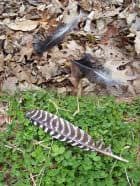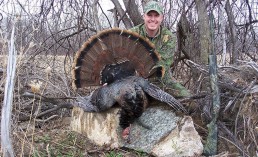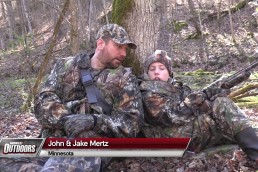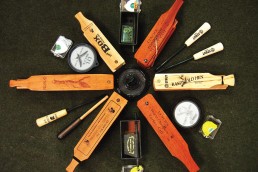Recovering a Wounded Turkey
SHARE THIS POST
If you hunt turkeys with either a bow or shotgun, every effort should be made to recover a wounded turkey. Unfortunately, if a bird doesn’t drop in its tracks after the shot, this can be extremely challenging given the fact that turkeys don’t bleed much due to their thick feathers absorbing most of it. However, by paying attention to the turkey’s reaction and making the right decisions, you should have no problem recovering your bird for the freezer.
Stick and string
With vitals not much larger than a golf ball, shot placement is extremely important when bowhunting turkeys. The best place to arrow one is in the base of its wing. This will likely hit the lung and heart area and prevent the turkey from flying off. However, they still have two legs and can quickly hightail it out of there in a hurry as I’ve found out. Therefore, consider an all- or-nothing shot to the head. Either you cleanly miss, or the bird has some serious problems. Whatever shot placement you choose, it is essential that you pay close attention to how the turkey reacts once the string is released. There is no guarantee that even the best-placed arrow will anchor the bird and keep it in sight.

If a gobbler takes off either running or flying after the shot, mark where you last saw the bird before it completely disappeared using a tree, rock or fencepost. Once you give the bird some time—about an hour—you can tie surveyor’s tape on this location as a reference for tracking. A GPS or compass can also be used to mark this spot. Resist the temptation to run after the wounded bird, which I have been guilty of on several occasions. This will only push it farther away and decrease your chances of recovering it. During the 2015 spring turkey season, my wife shot a longbeard with her crossbow in the wing bone without any good penetration. I made a decision to go after the bird to see if I could keep it in sight or to stay within hearing distance. Keeping up with a bird can be nearly impossible. Your best bet is to give it an hour or so before tracking it. In the meantime, hold your position and listen for any noises the turkey might make. These include leaves rustling, wings flapping or the bird “crash-landing.” After giving the bird some time to settle down, walk to the spot where you first shot the bird and look for any blood, feathers and your arrow, if it passed through. This will help give you clues as to how badly the turkey is hit.
Once you begin searching from the point where you last saw it, remain quiet and move slowly, scanning the ground for any disturbances in the leaves along with feathers. Wounded turkeys seldom travel more than a couple hundred yards and will choose almost any type of hiding place. They can be found in thick brush, tall grass, near or underneath logs, overgrown fencerows, along creek beds and at the base of large trees.
Once you find the bird, avoid fist pumps and high-fives until you know for certain that it is down for good. From a distance of 20 yards, watch for any type of movement coming from the head and body. Be prepared for a follow-up shot on the bird if necessary. If you find that there is no movement then congratulations, you have successfully recovered your turkey.
Are you enjoying this post?
You can be among the first to get the latest info on where to go, what to use and how to use it!
Shotgun
In the world of turkey hunting, anything can and will happen. Even while using a shotgun equipped with a full-choke and turkey load, there is still a chance you could miss one or wound one. When the moment of truth arrives and you make a decision to drop the hammer on one, it is essential to watch how it reacts after the shot. In all of the chaos this is easier said than done. No matter how many longbeards I have shot over the years, my nerves still find a way to mess with me.
A good shot placed in the head or neck will typically cause the bird to drop in its tracks immediately and begin the ritual of flopping around erratically. However, if his head is high and he appears to be unaffected by the shot that you just sent him, compose yourself and prepare for a follow-up shot if he remains within shotgun range. During the 2010 spring turkey season, I found myself in this type of situation. I was setup in a fencerow with my back against a large walnut tree when I heard gobbles coming from behind. Because the fencerow I had setup in was so thick with brush, there was no way for me to tell just how close he was without getting busted. I decided to keep my shotgun shouldered and pointed toward the field in hopes that the longbeard would walk directly in line with my barrel. After what seemed like forty-five minutes—which in the turkey world usually means about 15 minutes—the bird had followed the script. I fired a shot, but it kept on walking; however this time he picked up the pace. I then drew a bead on him again and this time I connected.
If the bird drops but flops around, quickly go after him and place the heel of your boot on its neck to finish the job. Make sure that when you do this you keep your gun pointed in a safe direction and lean outward from the turkey to avoid getting spurred. If a bird flies away or runs outside of your shooting range, avoid the temptation of taking any follow-up shots. Doing so will only risk wounding the bird. Instead, pay close attention to how the bird reacts and the direction it takes off before disappearing. If he is struggling when attempting to fly or runs away, then he has been hit. However, if it runs away and continues to stay in an upright position he is likely okay, but probably won’t come back. Either way, an effort should be made to check the area and look for signs that it is wounded.
Typically, a bird that is fatally injured by a shotgun won’t travel far. Most turkeys are recovered within about a 200-yard radius. The best place to start your search is right where you shot the bird. Unlike deer, turkeys generally travel in more of a straight line, but it is still important to walk from side to side or in expanding circles to cover more ground, especially when there are little signs of a hit. Typically, two pair of eyes are better than one, so consider bringing a friend along when trying to recover the bird.
Whether you hunt them with a bow or gun, wounding a turkey is something that all hunters dread. Occasionally, extenuating circumstances will occur that compromise the shot such as a branch, shooter error by rushing the shot or flinching and sudden turkey movement. What was once excitement and anticipation can quickly turn into frustration and worry within a matter of seconds. However, if you are patient, persistent, and put a recovery plan into action, there is no need to doubt that you will ever find the bird. It’s easy to get down on oneself, but remember in turkey hunting nothing is ever perfect. You have exhausted every effort humanly possible and that is all you can do.
MWO
SHARE THIS POST
Did you enjoy this post?
You can be among the first to get the latest info on where to go, what to use and how to use it!
Darin Potter
Darin Potter’s passion for outdoor writing began at the age of 12 when he first began writing in a journal that his parents bought him on a family camping trip in Northern Michigan. His writings have appeared in several Midwest publications: Michigan-Out-of-Doors, Michigan and Ohio Outdoor News, Modern Pioneer, and MidWest Outdoors.



